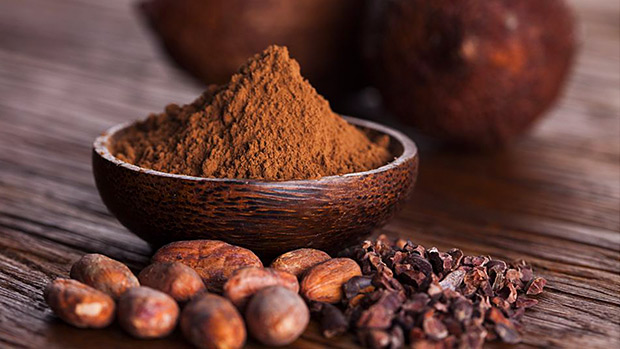
A couple of years ago, I wrote an article about how adding just a few grams of cocoa powder to your coffee can give it super powers.
It’s an origin story right on par with that radioactive spider biting Peter Parker, but rather than allowing you to climb up walls, the cocoa-enhanced coffee turns you, if you don’t mind me switching from the Marvel Universe to the DC Universe, into kind of a Brainiac.
The cocoa tamps down on coffee’s anxiety-producing effects while bolstering its cognition-enhancing effects. You get laser-like focus and more smarts without the jitters.
What happens is that two cocoa phytochemicals – theobromine and epicatechin – bind to adenosine and benzodiazepene receptors, thereby reducing anxiety and improving motivation, mood, attention, and error rates. (1)
It’s pretty amazing.
More recently, I wrote another article about how ingesting cocoa powder in the form of chocolate bars can actually improve your health, doing things like lowering your risk of dying from a host of diseases, increasing testosterone levels, giving you firmer erections, helping you stay slim, improving gut health, and even growing more muscle by inhibiting myostatin, a protein that slows or interferes with muscle growth.
But as I’ve continued to research the topic of cocoa’s health benefits, I’ve found that there’s a problem with cocoa that has to do with how it’s processed.
As such, I can no longer whole-heartedly recommend cocoa because I’ve found something that does all the things cocoa’s supposed to do, only better. It’s cacao, and despite what you’ve heard, it’s not the same thing as cocoa. Well, not exactly.

It’s Cocoa Before It Got Corrupted
When I wrote that coffee/cocoa article I referenced above, I warned against using “Dutched” cocoa powder, which is something manufacturers do to it to change the color of the cocoa (darken it so it looks more chocolaty) and reduce the bitter flavor.
Dutching comes at a price, though. It involves treating the cocoa beans with alkali and that chemical process substantially reduces the levels of theobromine, epicatechin, and other phytochemicals that are responsible for cocoa’s magic.
Instead, I recommended buying non-Dutched cocoa, which is a little more difficult to find than Dutched cocoa, but still readily available in the “baking” section of the grocery store.
Similarly, when I wrote about eating chocolate bars, I stressed buying bars that were at least 70% cocoa, which, while usually being made with beans that were treated with alkali, would provide at least some phytochemicals to let you cash in on all that elevated testosterone, increased muscle, better gut health, and less dyin’.
But as I did more research, I found that just about everything manufacturers do to a cocoa bean, starting with fermentation and progressing to roasting and Dutching, reduces phytochemical levels.
And it doesn’t always stop there. Once you take the cocoa home and combine it with baking soda – as you might when you’re making a Grandma Luoma’s Diabetic Coma Chocolate Cake – it starts a chemical reaction that further depletes the cocoa of its beneficial phytochemicals.
So what we need to do is pick the least processed form of cocoa we can find that qualifies as food. Case in point, we can’t very well use the raw beans because they’re coated with a kind of disgusting mucilage that makes the beans look like a pod of baby banana slugs. No, we need to wait until the beans have been fermented, dried, and cold pressed.
At this point, the product is called cacao. As far as processing, it’s still fairly virginal and has retained most of its nutritive qualities. If, however, we continue the processing by roasting the powder at high temperatures, it’s generally referred to as cocoa. Dutching adds further insult.
Now, chocolate experts the world over might nitpick over where exactly cacao becomes cocoa, but for our purposes, let’s assume cacao is the raw, unrefined bean, and cocoa refers to the bean after it’s been roasted and chemicalled up.
How to Use Cacao
My basic recommendations regarding the use of chocolate powder still apply, only I’ve pivoted to using cacao instead of cocoa. To supercharge your coffee, add 2-3 grams (about a teaspoon) of cacao. It contains more fat than cocoa powder does, so it should mix into your coffee fairly well.
It also makes a great, chocolaty addition to your protein shake, yogurt, cereal milk, or anything else you might want to jazz up.
Unroasted and cold-pressed cacao, while not common, is still pretty easy to find. Amazon offers Navitas brand of organic cacao for well under 10 bucks. You can also buy chocolate-bar type products that are made with cacao instead of cocoa. Alternately, you can find cacao “nibs” (small pieces of crushed beans) that you can use in the same way as you might the powder.
Add cacao to your coffee to supercharge it, but if you like your coffee unadulterated, make sure you add a teaspoon or so to some other food or liquid at least once a day to enjoy cacao’s long list of healthful benefits.
References
- Ali Boolani, Jacob B. Lindheimer, Bryan D. Loy, Stephen. “Acute effects of brewed cocoa consumption on attention, motivation to perform cognitive work and feelings of anxiety, energy and fatigue: a randomized, placebo-controlled crossover experiment,” BMC, 13 January 2017.
- W Jeffery Hurst et al. “Impact of fermentation, drying, roasting and Dutch processing on flavan-3-ol stereochemistry in cacao beans and cocoa ingredients,” Chem Cent J., 2011;5:53.
- Gabriela Gutierrez-Salmean, et al. “Effects of epicatechin on molecular modulators of skeletal muscle growth and differentiation,” The Journal of Nutritional Biochemistry, 2014. PubMed, PMC.
- “Effect of Treating Cocoa with Alkali: The Dutching Process,” Life Extension News, Volume 16 No. 1, January 2013.























